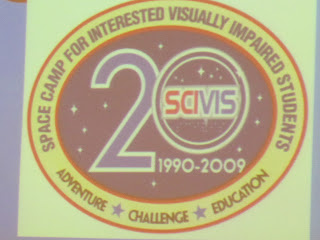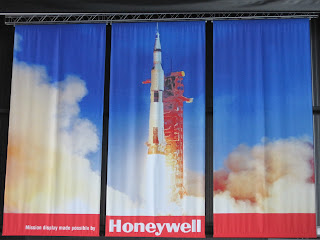Space Camp – Day #5
At breakfast, we presented our leader with our Team Unity
patch. He was overwhelmed!
- The hands at the bottom are our team symbol – we were united.
- The Earth and flags symbolize the nations represented on our team: USA, Scotland, United Kingdom, and India. Actually, one of the teachers is from England, lives in France and teaches in Switzerland.
- There are 15 stars, representing the 15 team members.
- We referred to our Jamie Putman, our team leader as Polaris, the North Star. We looked to him for direction and guidance, and he always kept us on the right path. The large star with the letters “JP” are for him.
- The Space Shuttle and Lunar Lander represented our missions. (We also simulated a mission aboard Orion to Mars.)
- The names “Inspire” and “Empower” are what we hope to do for students once we return to the classroom in the fall.
- The people holding hands represent our students as well as our team.
- We are forever grateful to the Honeywell Corporation for funding our Space Academy experience.
After breakfast we were learned how to extract DNA from
fruit. I wonder how this process would
be different if done in space?
We extracted DNA from peaches, strawberries, and kiwi fruit.
The light colored, bubble laden material at the top of the tube is strawberry DNA.
This is hard work!
Extracting DNA can be fun if done with friends!
This is DNA from a strawberry.
Expert DNA extractors!
After lunch, were given a presentation about life on the
International Space Station (ISS). We
learned lots of things that would be interesting to middle school
students. For example:
- How do you sleep?
- What kind of food do you eat?
- How do you prepare food in space?
- What chores do the astronauts have?
- How about exercise?
- What kind of exercise do astronauts do and why is it needed?
- What is the bathroom like? (Interesting side note: Not surprisingly, the toilet is a bit different – so the astronauts need to be “Potty trained” prior to their missions! They need to practice a different type of “Target Training”!)
- And something I never thought about before; many astronauts get motion sickness at the beginning of their mission in space. What happens if someone vomits in space? (See, I told you these topics would be interesting to middle school students!)
I attended the Honeywell Space Academy for Educators. There are, however, many more programs
offered at the US Space and Rocket Center.
There are Space Camps for almost every age group. Aviation Challenge is a program for students
interested in becoming a fighter pilot.
Dan Oates, director of Special Programs, talked with us about Space Camp
experiences for children with special needs – including those with limited or
no eyesight!
Click here to learn more about Space Camp Programs. See me if you are interested in going. We will try to find a way to send you to camp!
Our final educational session was given by the NASA Educator
Resource Center. There are so many
resources available to us! It is
amazing. Lesson plans, Cd's and DVDs,
video up links, mission updates, speakers, posters, back ground information,
etc! They were so generous! I almost exceeded the weight limit of my
luggage on my return trip to Ohio!
The culminating experience of the week was our graduation. There were six teams that graduated:
Columbus, Destiny, Harmony, Kibo, Zarya, and Unity. Each team had 13 to 15 members. All in all there were 37 states and 19
countries represented among the 85 teachers that attended the Space Academy.
Before the actual graduation ceremony, Jamie (our team leader), put our names upside down on our flight suits.
My suite-mates during
the Space Academy (from left to right):
Gillian (Gilli Vanilli)
from Scotland
Me (Duct Tape)
Whitney (HM) from
Texas
Laine (Sunscreen) from
West Virginia
We all earned
“handles” or code names. Others
included: Papa Bear, Preacher, Hip Hop, Space Cowboy, Parachute, Princess, and
Are we there yet?
Astronaut Leland Melvin was our graduation speaker.
He liked to build things as a child and once set his mother’s living room carpet on fire while doing a chemistry experiment. (Mom and Dad, aren’t you glad that I had my chemistry set in my “laboratory” out behind the garage under the pine trees?) He played sports though out school and was drafted by the NFL.
He is interested in supporting STEM
education for middle school students, and currently works with NASAs Summer of
Innovation Project.
He is working with American Rap Star
Will.I.Am to write a song about the NASA Space mission to Mars. The song’s debut will be played in outer
space and transmitted back to Earth!
Cool!
Go to this link to learn about
Will.I.Am’s interest in the “Spin off” benefits of NASA’s Space technology: http://www.spacesafetymagazine.com/2012/04/02/rap-arist-will-i-am-introduces-nasa-spinoff-technology/
During graduation, our names are
ripped off by the director of the Space Academy and replaced right side up. We
are also given our wings which we wear on our lapels.
And I thought it couldn’t get any
better than this! After graduation, Honeywell
gave us a graduation dinner and party that I will never forget.
Our banquet was in the Saturn V Rocket Hall. The 363 foot Saturn V rocket with the Apollo Payload is displayed horizontally. The three stages are separated for educational purposes. It is the largest rocket ever constructed and in 1968 was the first manned spacecraft to leave earth orbit and propelled many astronauts to the moon. We ate directly under the capsule stage of the rocket.

Great food, wonderful people, and terrific dance music! It sure was fun celebrating with all of the new friends I had made this week. The friendships made this week will last a life time.
Our banquet was in the Saturn V Rocket Hall. The 363 foot Saturn V rocket with the Apollo Payload is displayed horizontally. The three stages are separated for educational purposes. It is the largest rocket ever constructed and in 1968 was the first manned spacecraft to leave earth orbit and propelled many astronauts to the moon. We ate directly under the capsule stage of the rocket.
Great food, wonderful people, and terrific dance music! It sure was fun celebrating with all of the new friends I had made this week. The friendships made this week will last a life time.
Thank you Honeywell! I would especially like to thank all of the
Honeywell employees who donate in order to make this program a reality.
For more information about Honeywell
go to: http://honeywell.com/Citizenship/Pages/corporate-citizenship.aspx







































































